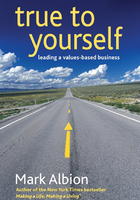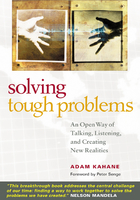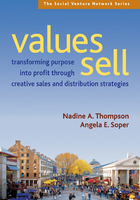PETER B. VAILL, UNIVERSITY OF ST. THOMAS
In a favorite book of meditations, John Thom, a 19th-century clergyman, is quoted as follows:
The real corrupters of society may be, not the corrupt, but those who have held back the righteous leaven, the salt that has Lost its savor, the innocent who have not even the moral courage to show what they think of the effrontery of impurity, the serious, who yet timidly succeed before some loud-voiced scoffer-the heart trembling all over with religious sensibilities that yet suffers itself through false shame to be beaten down into outward and practical acquiescence by some rude and worldly nature. (Tileston, 1934, p. 221)
Bob Greenleaf could have written this paragraph. He might have been a little more informal about the matter. He would have been careful not to sound holier than thou as he spoke of the lack of moral courage and "hearts trembling with false shame." I do think, though, that these last essays of his reveal over and over, in dozens of ways, the courage the paragraph calls for. Greenleaf would have smiled at the realization that his work indeed can be seen as the "righteous leaven" for his favorite subject: organizations and how things get done in them.
I feel privileged to be able to introduce this collection. I don't begin to think I understand these essays in their true depth and implications, but repeatedly as I have read through them and reflected on them, I find myself saying, "Yes, he's right and what he's saying is terribly important." His deceptively casual writing style draws me into thinking along with him. I am sure other readers have the same experience with his thought that I do-of finding him saying something that is just about in so many words what has occurred to one independently. Yet I never find him derivative or simply rehashing. Instead I, at least, find myself wondering why I haven't been more insistent about the point Greenleaf is making, why I haven't taken the idea and made it the righteous leaven of my work. His is both a familiar voice and an original one.
Greenleaf has what we may call a "big idea." It is the idea of the servant as leader, and many of these essays are his last explorations of the extraordinary implications of that notion. The big idea is that leadership, in the final analysis, must be about service. That is the only way it can both sustain itself as leadership and truly offer to its colleagues and "followers" the benefits of its insights and its energy. Greenleaf's idea resolves one of the oldest paradoxes of the leadership field: how can a leader be both concerned about the "task" and mindful of the "social," "concerned for production and concerned for people," "effective" in getting work done and "efficient" in not causing all kinds of human problems in the process? Every leadership theory tries in one way or another to deal with both of these "dimensions." The big idea about service-Greenleaf probably would not like this description-is that it is both an attitudinal and behavioral concept. It combines a concern for getting things done with attention to the needs of those who are getting things done. There are not two functions; there is only one-servanthood.
Greenleaf's challenge is to make a worldly and pressured-and somewhat distracted, exhausted, and frightened-society of leaders and potential leaders believe it. These essays are the last we shall see of him speaking his truth as plainly and insistently as he can.
In the next few paragraphs, I want to say a few more things about the big idea. Then I will close with a few more reflections about Greenleaf the man.
There are five themes in Greenleaf's way of talking about "the servant as leader" that strike me as quite significant. They are as follows: (1) the grammar of the phrase itself; (2) Greenleaf's commitment to practice; (3) the importance of mission; (4) the nature and role of "persuasion"; and (5) his idea about a "theology of institutions." These five themes appear repeatedly throughout his writings, yet, except for his discussion of mission, Greenleaf himself is frequently so offhand and low-keyed in the way he talks that the significance of the idea may be missed.
1. The grammar of "the servant as leader." As the reader is no doubt aware, Greenleaf's idea is frequently abbreviated to "servant-leadership," or "servant leadership." For purposes of economy and simplicity, it is probably necessary to abbreviate Greenleaf's phrase in this fashion. But the danger is that a key feature of his big idea will be thereby lost. In the phrase "the servant as leader" (which after all was Greenleaf's title for the original seminal essay), the subject is the servant or service; the predicate is the leader. His phrase is an application of the philosophy of service to the practice of leadership.
As is apparent in various writings in the present volume, service was the most important thing for Greenleaf. He frequently takes the time to ground the phrase in biblical references and connect it to the deepest yearnings of the human spirit. To be sure, Greenleaf is deeply concerned about leadership, but his concern is that it is being practiced (and theorized about) without reference to service. For Greenleaf, service is the moral dimension of prime importance, not just for leadership but for life. It is service he fears has been lost sight of, not leadership. To put it compactly, I think Greenleaf is saying that leadership is a special case of service; he is not saying that service is a special case of leadership.
This distinction is important because we live in a period when there is an almost frantic casting about by leaders and leadership thinkers for answers to the profound dilemmas of leadership in our turbulent and unpredictable world. Some will take up Greenleaf's notion and test it for the extent to which it "solves their leadership problem." The "servant as leader" idea does not solve the leadership problem in the sense that leaders and scholars might hope. If anything, it will frustrate and annoy such seekers. Soon we will hear them saying, "Servant-leadership? Oh yeah, right, we tried that." But this misunderstands Greenleaf's challenge. As I understand him, he is not asking, "What service can you render as a leader?" but rather "What leadership can you exercise as a servant?"
2. Greenleaf's commitment to practice. Repeatedly in these essays, Greenleaf reminds us that he is writing about the servant as leader as a student of how things get done in organizations. He wants us to look concretely at the way the actions and attitudes of service can transform relations among concrete human beings. His short answer to the question, I think, would be, "In the long run, things get done among human beings, including within organizations, by people serving one another." That is what his experience has taught him, and for which he thinks there is overwhelming confirmatory evidence throughout human history.
Greenleaf's interest in practice has several dimensions that, taken together, give him quite a different outlook from most other contemporary writers on leadership. For one thing, he knows how complex any process of action is in an organization. His repeated references to his own business experience as well as to his many extensive contacts with other organizations make clear that he has no illusions about how unstable and dicey organizational action can be. His commitment to action is also seen in his consistent attention to the process by which his ideas can be implemented. Just about when I, as a reader, am thinking, "Sounds good, but how are you going to do that?" it turns out that Greenleaf has been asking himself the same question; and so he proceeds to offer a few thoughts about how what he is talking about can happen.
Another feature of his commitment to practice is his concern for the process by which more servant-leaders can be produced. Yes, he wants men and women in positions of influence to consider his ideas, but he is equally concerned with increasing the sheer number of younger men and women who will be helped to develop as servant-leaders.
This concern leads him to challenge educational institutions in exactly the way that they (as a professor, I should say "we") need to be challenged: we in higher education know that only by accident are we producing visionary young men and women who aspire to leadership, to the extent we are producing them at all. We don't like to admit it. Greenleaf has found us out.
Finally, his concern for practice focuses him on the way that any organization works. It is clear in this book that in the later years of his life, as well as at AT&T, he moved among the high and the mighty of society's major institutions: universities, businesses, foundations, and the like. As he quietly but firmly repeats his interest in how things get done, it is as if he were saying, "I know all of you are terribly important people who feel that what your organizations do is terribly important in society. But my angle of vision has taught me something about the way your institutions work and don't work that perhaps you are unaware of." We live in an age of "content experts" who know all about moon landings and heart transplants and giga-sized databases and global markets and transformations of the biosphere-and many of them are leading or aspire to lead institutions concerned with those things. Greenleaf is a process expert, and he has been thinking about phenomena that often get lost in the swirl of events that our organizational leaders are so good at triggering.
3. The importance of mission. One can hardly read a page of these essays without encountering Greenleaf's deep beliefs about the importance of mission in organizations. He, of course, is not the only or the first writer on organizations to declare the importance of mission. But as we reflect along with him in his various discussions of missions, I encourage us to keep in mind a deep conundrum-one that I think Greenleaf himself is quite aware of. The question is, Where does a sense of mission come from? The power and importance of mission, once articulated, is unquestionable. But how does it happen? What is the process by which a deep sense of an organization's reason to be gets into the collective psyche of its members? Greenleaf realizes what a tough question this is. He also realizes that a convenient answer is that some charismatic individual steps forward and articulates a mission full-blown-and there are even places in these essays where Greenleaf seems to be personally attracted to this "Great Man" model of leadership.
But I think he knows better. Without denying that a single individual can occasionally say or do something that has the requisite galvanizing effect, Greenleaf knows that servanthood is not about stepping forward and taking charge. Rather, I think he understands that there has to be such a thing as service to the mission-formulation and articulation process itself. That is different from doing people's thinking and feeling for them. Greenleaf's servant-leader is a servant of the organization's learning process, I think. About that, the servant-leader is tough-minded and unflinching. Ways must be found whereby organization members can come together on a dream.
4. The nature and role of persuasion. Greenleaf is particularly eloquent about the role of persuasion in servant-leadership. He uses the term in its everyday sense, and I think he would not be impressed with what the academic world has done with the concept. Nor would he accept a cynical view of persuasion that equates it to manipulation or slick rhetoric.
There is healthy and honest persuasion. I think Greenleaf wants us to envision ordinary conversation between people where at least one, but hopefully many or most, are trying to say things to each other and do things for each other that are in service of a common dream or sense of mission that they share. "Persuasion" is the process of one person co-creating to another or others what he or she thinks pursuit of the mission entails, including statements about the meaning of the mission and/or the need for new attention to its meaning. The service is in the thought, the creativity, the information, the experience, and the energetic vision the co-creator feels. I have seen these conversations many times. They occur all the time in excellent organizations-what in a series of studies some years ago I called "high performing systems." In these conversations committed people are doing everything they can to help each other. Greenleaf doesn't see why a more widespread philosophy of service to a mission or a dream can't occur almost anywhere. My own studies and experience convince me he is quite right: there is no type of organized human activity where mutual service to a common vision and the energetic reminding of each other of what is involved (i.e., persuasion) cannot happen.
5. A theology of institutions. I find Greenleaf's speculations on the idea of a theology of institutions or organizations one of the most interesting and original notions in his writings. While quick to state that he is not a theologian, and therefore does not know what is required for a body of ideas to be a worked-out theology, he nonetheless seems very sure that such a theology is needed and should be possible. He does not see why, if there can be a theology of persons, there cannot be a theology of organizations.
He is not talking about theocracy, not about top-down governance and control by theocratic principles and doctrines. He is far too independent a thinker and a man for that. No, I think he wants us to reflect on what the fundamental nature of a human organization is; how we regard it. Is it a pure invention for secular purposes? Just a vehicle, at bottom an ad hoc arrangement with no claim to a deeper significance and justification for its existence? My guess is that Greenleaf perceives intuitively that the mission or vision or dream has a quality beyond its verbal, secular content. He would like to see us work out what this quality is, and his hunch is that when we do we will find ourselves reflecting on the relation of this dream to the spiritual worldviews that we are already familiar with for persons. My main point, though, is to invite the reader to reflect deeply on these comments of Greenleaf's about a theology of institutions. They may turn out to be among his most original and significant insights.
A Final Word
Most of the essays in this volume have been previously published in pamphlet form by the Greenleaf Center for Servant-Leadership. At the back of most of these pamphlets is a brief biography of Greenleaf and a photograph of him taken apparently late in life. This photograph of Greenleaf may have a significance in his life or for those close to him that I am not aware of. Inquiries at the Center did not result in any particular stories about the photo or the reasons for its use.
Yet I consider it so extraordinary an image-one that stimulates thoughts and feelings in me that are pertinent to the spirit of these essays and to this Foreword. The picture is almost a direct frontal of his head and shoulders, open-collared and informal. He is turned very slightly to his left from the camera and the effect is to place the left half of his face almost completely in shadow while the right side remains fully illuminated. His silky white hair lies smoothly on the right side of his head but is invisible on the left. The head is tilted just slightly upward and the mouth is set in a patient composed line-not preparing to speak, but not relaxed either. Even though half-lit, the nose is strong and suggests that in profile he might have been distinctly "hawklike." It is a striking picture, and made the more so by one final feature: it is dramatically off-center. Greenleaf's head and shoulders occupy the right half of the picture, but the left half is blank space. This left half is strongly illuminated at the bottom and shades to black at the top, but is completely empty. Most of us, on pulling such a snapshot out of the envelope in the supermarket parking lot, would immediately judge the picture to be not worth saving because it is so off-center. The longer I look at this picture the more I am stimulated to think about Greenleaf as a person. There is a darkness running through his writings. He is writing about terribly complex problems which contain the potential for some very bad outcomes-and he knows it. Yet he is not wringing his hands, not paralyzed with alarm. The mouth is composed; the eyes are sharply engaged, but kindly (this judgment about the eyes being one that a friend of mine independently described the same way). The shadow down the middle of the face with the wispy white hair and the off-center placement make me feel as if I am sitting there talking to him, perhaps in the evening with late light coming horizontally through the window onto half of his face as he sits talking to me.
The slight uptilt to the head, the direct gaze, and the mouth that has said a lot and could say more but does not at the moment feel the need, combine in a sort of friendly but quizzical challenge. "I am coming from both darkness and light," says the face, "both out of problems and possibilities. I may even be a little off-center myself in my understanding of these things. But tell me: are you going to do anything about them?" Am I-are we-indeed?
References
Tileston, M. Daily Strength for Daily Needs. New York: Putnam, 1934. (Originally published in 1884)















